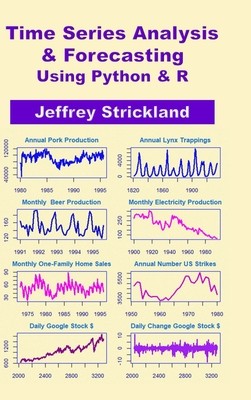
- We will send in 10–14 business days.
- Author: Jeffrey Strickland
- Publisher: Lulu.com
- Year: 2020
- Pages: 448
- ISBN-10: 1716451132
- ISBN-13: 9781716451133
- Format: 15.2 x 22.9 x 2.5 cm, hardcover
- Language: English
- SAVE -10% with code: EXTRA
Time Series Analysis and Forecasting using Python & R (e-book) (used book) | bookbook.eu
Reviews
Description
This book full-color textbook assumes a basic understanding of statistics and mathematical or statistical modeling. Although a little programming experience would be nice, but it is not required. We use current real-world data, like COVID-19, to motivate times series analysis have three thread problems that appear in nearly every chapter: "Got Milk?", "Got a Job?" and "Where's the Beef?" Chapter 1: Loading data in the R-Studio and Jupyter Notebook environments. Chapter 2: Components of a times series and decomposition Chapter 3: Moving averages (MAs) and COVID-19 Chapter 4: Simple exponential smoothing (SES), Holt's and Holt-Winter's double and triple exponential smoothing Chapter 5: Python programming in Jupyter Notebook for the concepts covered in Chapters 2, 3 and 4 Chapter 6: Stationarity and differencing, including unit root tests. Chapter 7: ARIMA and SARMIA (seasonal) modeling and forecast development Chapter 8: ARIMA modeling using Python Chapter 9: Structural models and analysis using unobserved component models (UCMs) Chapter 10: Advanced time series analysis, including time-series interventions, exogenous regressors, and vector autoregressive (VAR) processes.
EXTRA 10 % discount with code: EXTRA
The promotion ends in 18d.03:31:56
The discount code is valid when purchasing from 10 €. Discounts do not stack.
- Author: Jeffrey Strickland
- Publisher: Lulu.com
- Year: 2020
- Pages: 448
- ISBN-10: 1716451132
- ISBN-13: 9781716451133
- Format: 15.2 x 22.9 x 2.5 cm, hardcover
- Language: English English
This book full-color textbook assumes a basic understanding of statistics and mathematical or statistical modeling. Although a little programming experience would be nice, but it is not required. We use current real-world data, like COVID-19, to motivate times series analysis have three thread problems that appear in nearly every chapter: "Got Milk?", "Got a Job?" and "Where's the Beef?" Chapter 1: Loading data in the R-Studio and Jupyter Notebook environments. Chapter 2: Components of a times series and decomposition Chapter 3: Moving averages (MAs) and COVID-19 Chapter 4: Simple exponential smoothing (SES), Holt's and Holt-Winter's double and triple exponential smoothing Chapter 5: Python programming in Jupyter Notebook for the concepts covered in Chapters 2, 3 and 4 Chapter 6: Stationarity and differencing, including unit root tests. Chapter 7: ARIMA and SARMIA (seasonal) modeling and forecast development Chapter 8: ARIMA modeling using Python Chapter 9: Structural models and analysis using unobserved component models (UCMs) Chapter 10: Advanced time series analysis, including time-series interventions, exogenous regressors, and vector autoregressive (VAR) processes.


Reviews